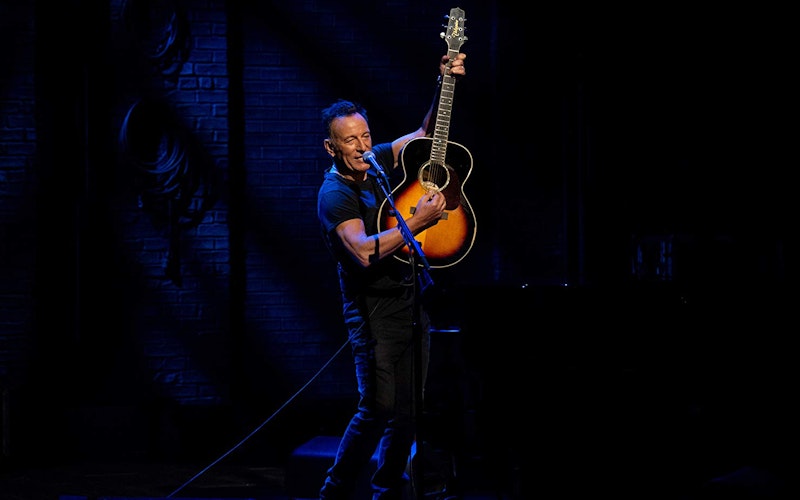
Movies
Springsteen on Broadway: Born to Run, and Return
A black T-shirt with a chain tucked beneath. Black jeans. Black boots.
Bruce Springsteen wraps himself in the standard-issue rock star uniform during Springsteen on Broadway. He might as well be wearing his birthday suit.
The Netflix concert film—which chronicles his wildly popular one-man show—finds Springsteen presenting his superhero origin story. Rather than tear his garments to reveal a giant “S,” he spends two and a half hours razing facades and pruning fig leaves. The songwriter who penned the lyric, “Tonight I’m gonna get birth naked and bury my old soul / And dance on its grave” (from “Long Time Comin,’” recreated beautifully here) gets down to that business.
Springsteen on Broadway carves out space for soulful, stripped-down renditions of beloved cuts such as “Born to Run,” “The Rising,” and “Dancing in the Dark.” But the monologues far outweigh the music, as Springsteen breaks the performer’s golden rule to reveal how he learned his “magic trick”: making an audience believe in the existence of a collective “us.”
Pulling magic from a hat comes quite natural to this Jersey boy. “I come from a boardwalk town where everything is tinged with just a bit of fraud ... So am I,” Springsteen says in the show’s staggering first minutes. But true magic happens when you quiet that boardwalk impulse and stitch your heart onto your sleeve. “All you had to do is risk being your true self,” he says. The true Springsteen comes through here in loud, riotous anecdotes and clear-eyed confessions. For the thousands of hours Springsteen has spent on stage and all the rock-and-roll sermons he’s told, there are moments here—his voice drawn down to a whisper—where you get the sense he’s telling you something he’s never told another soul.
Self-aware enough to make himself the butt of a career-spanning joke, he notes he’s never seen the inside of a factory, even as the trials of blue-collar life provide the substance and setting for so many of his songs. “I’ve never worked five days a week until right now,” he says to the crowd’s laughter. “I don’t like it.”
Growing tender at times, he mingles love and lament as he conjures up the spirit of his connection to dearly departed saxophonist Clarence Clemons. Digging into complicated relationships with his parents, another subject of many songs, he speaks with the reverence of a child and recognition of a grown man. Springsteen describes his father in mythic terms, even as he recounts the man’s many flaws; he calls him his “hero” and “greatest foe” in nearly the same breath. Perhaps even more revealing, Springsteen identifies his mother as the first person to introduce the possibility of being known and accepted. In her, he says, he first encountered pride in someone he loved, someone he knew loved him back.
Springsteen spends two and a half hours razing facades and pruning fig leaves.
The stories reign supreme, but the songs are consistently sublime. Attaching chords to the sort of self revelation which threads the show together, he wordlessly sings the coda to “Thunder Road,” perhaps the most beautiful passage in all of pop music. Springsteen has played those notes with a full, electrifying band and on a piano’s keyboard. He’s breathed and blown them through a harmonica, as he does for a few bars here. Switching to a simple “la-da-da,” he proves all those notes need to level the soul are themselves, pure and unadorned.
Elsewhere, he plays a version of “The Promised Land” that will make you weep, then shout “Hallelujah.” He delivers “Born in the U.S.A.” as a Robert Johnson-at-the-crossroads slice of blues. The brightest highlight of the set comes when Springsteen welcomes wife and longtime collaborator Patti Scialfa to the stage to sing two songs. Springsteen is at his most naked and unashamed when he dares perform “Brilliant Disguise,” a song about the masks we wear in marriage, with his closest companion standing mere feet away. Introducing the song, he speaks plainly about the potential risk and reward of drawing someone close enough to see you. “Trust requires allowing others to see as much of our real selves as we have the courage to reveal. I don’t want to see my real self. Why would others want to?” he says.
That question is a perfect summation of everything humans lost when Adam and Eve sunk their teeth into forbidden fruit. The ability to be known by one another and by God vanishes. A tragic game of hide-and-seek—first physical, then spiritual—ensues. Seeing ourselves with all our blemishes, judging ourselves unlovely, we struggle to believe anyone else could see and love us still.
Salvation begins to reverse the curse. We begin to see ourselves the way God does—as beautiful, beloved children. More than this, recognizing that God knows us fully, yet loves and will never leave us, we relax into that love and open up like flowers, to fully blossom and flourish.
Springsteen can’t guide us back to the garden—not completely. But Springsteen on Broadway is a step of faith, a model of what it looks like to bare your soul, believing that risky enterprise will be met with love. Springsteen’s Broadway setting underscores the idea that life is theater. But his spirit on stage conveys it doesn’t have to be all smoke and mirrors. To know Springsteen, the way he is here, is to love him. For once, he suggests, we weren’t born to run after all.
Topics: Movies